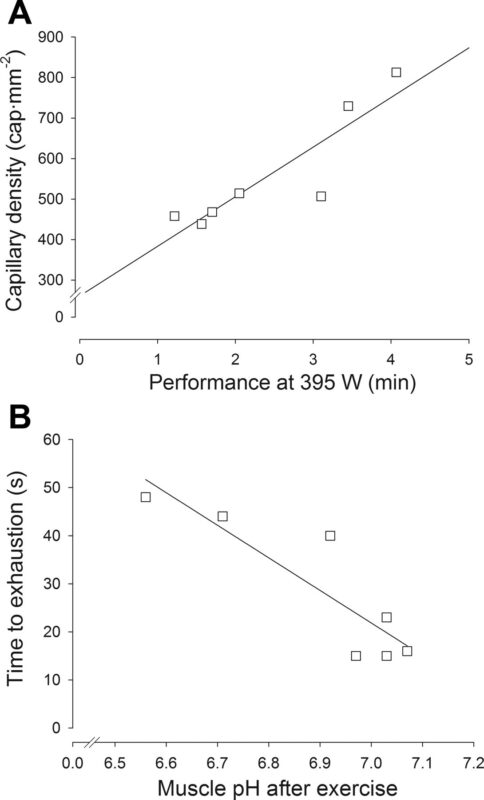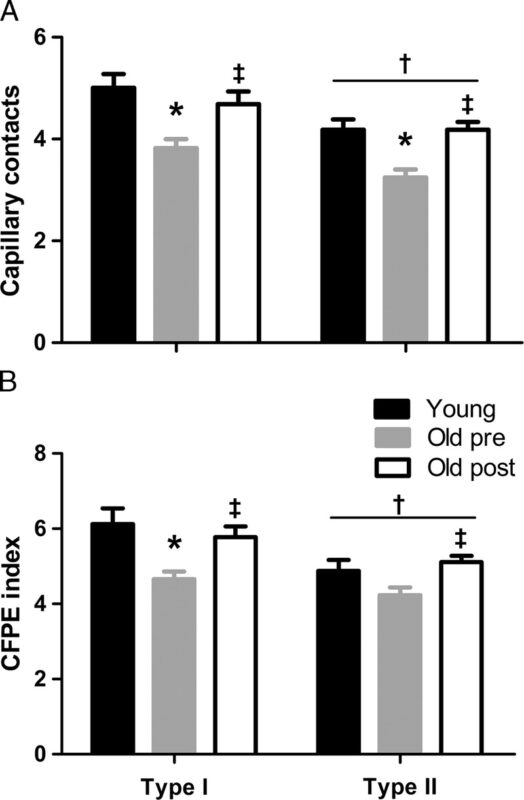New studies are showing the benefits of exercise on blood vessel growth and aging muscle. The loss of muscle tissue, called sarcopenia, is a natural part of the aging process. These new studies show that steady exercise can help to overcome the loss of muscle tissue well into later years.
Loss of muscle tissue starts with loss of capillary density
One recent study confirms the loss of muscle tissue is related to greater insulin resistance (sometimes accompanied by type 2 diabetes) in later years, along with lower capillary density in skeletal muscle tissue. With lower amounts of oxygen and nutrients being delivered to muscle tissue, muscles begin to atrophy and sarcopenia sets in.
“In agreement with earlier research, we show that insulin sensitivity is reduced in both healthy as well as type 2 diabetic older adults compared with healthy young controls” (1)
“Similar observations were made for skeletal muscle mass, with significantly less skeletal muscle tissue in the healthy and type 2 diabetic older men compared with the younger controls” (1)
“Impairments in microvascular function may be attributed to a lower capillary density and/or impairments in endothelial wall function… compromising nutrient exchange over the endothelium… and, as such, may be one of the underlying mechanisms responsible for the loss of muscle mass with aging” (1)
Fewer small capillaries observed in older adults
The study also showed that small capillaries, especially well-perfused or permeable ones were less prevalent in older adults, especially those with type 2 diabetes. This loss in number of fine capillaries is another reason why muscles tend to atrophy in older adults.
“Smaller capillaries tended to be less prevalent in the older and older type 2 diabetes patients compared with the healthy young controls” (1)
“The observation of a lower capillary density in leg muscle tissue in the older and older type 2 diabetes patients seems to agree with the apparent loss of well-perfused small nutritive capillaries” (1)
Exercise linked to increased capillary density
Another new study suggests that capillary density can be improved by cardiovascular exercise, leading to increased muscle density and growth. Capillary density was deemed the most important factor in low intensity of exercise.
“The capillary density was related to exercise time” (2)
“A relationship was also observed between the percentage of FTx fibers and the exercise time” (2)
“The number of muscle capillaries has often been positively associated with performance during low-intensity exercise” (2)
“The major findings of the present study were that significant relationships were observed between capillarization and the time to exhaustion during intense cycling bouts” (2)

In another study, researchers fed 400 mg/kg of NMN per day to 20-month-old mice, an age comparable to 70 years in people. After two months, the mice had increased muscular blood flow, enhanced physical performance and endurance and the old mice became as fit and strong as young mice. (7)
Cardio exercise induces an increase in muscle capillary density
As muscles are exercised, they have an increasing demand for oxygen and nutrient delivery. This demand initiates an increase in muscle capillary density.
“Capillary density is closely associated with the oxygen and metabolic demand of skeletal muscles” (3)
“a significant relationship was found between the number of capillaries per mm of muscle cross-sectional area and the number of repetitions performed” (3)
“The subgroup of subjects who participated in systematic athletic training performed more repetitions… and had a higher capillary density” (3)
However, maximum strength training such as heavy weightlifting induces a decrease in muscle capillary density. Weight training using moderate weights and higher repetitions, though, can lead to higher capillary density.
“training for maximum strength induces a decrease in muscle capillary density because of parallel increases in muscle fiber cross-sectional area” (3)
“However, resistance training with high volume, moderate intensity, and limited rest between sets leads to a greater capillary density compared to resistance training aiming for maximum strength” (3)
Insulin sensitivity correlated with capillary density
Insulin sensitivity was shown to be correlated with capillary density and the proportion of muscle fiber types. Insulin may work by influencing oxidative capacity of muscle tissue.
“we have found in vivo insulin action to be significantly correlated with capillary density and the proportions of muscle types in musculus vastus lateralis” (4)
“We postulate that the association of insulin action and capillary density reflects the effect… perhaps associated with alterations in muscle cell oxidative capacity” (4)
Resistance training well established strategy to increase muscle mass and function in older adults
It is well established that resistance training in older adults can stave off signs of muscle decline from sarcopenia and increase muscle mass and function. Exercise has been shown to increase capillary density and insulin sensitivity.
Resistance exercise enhances muscle capillarization in older adults
Muscle tissue tends to atrophy as we age and sarcopenia sets in. Maintaining capillary density through exercise is a key determinant of the ability to deliver vital oxygen and nutrients to muscle tissue.
“Resistance-type exercise training can effectively augment skeletal muscle fiber size and capillarization in older men.” (5)
“The greater capillary supply may be an important prerequisite to reverse anabolic resistance, support muscle hypertrophy, and improve metabolic health during lifestyle interventions aiming to support healthy aging.” (5)

Heavy-load exercise has strong impact on muscle gene expression in older adults
Heavy-load exercise changed RNA gene expression in those over 70 years old to a more significant degree than younger adults. These transcriptome changes had a predictive increase in vascularization and muscle contractions, suggesting highly beneficial health effects for older adults.
“Younger adults, showed few transcriptome changes, but a marked, significant impact was observed in persons of average age 70 years and even more so in persons above 80 years.” (6)
References:
5 – Resistance Training Increases Skeletal Muscle Capillarization in Healthy Older Men
7 – Impairment of an Endothelial NAD+-H2S Signaling Network Is a Reversible Cause of Vascular Aging
